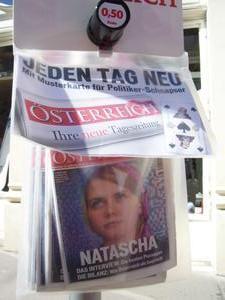Advertisement
Published: October 2nd 2006

 Natascha Natascha
Natascha Natascha
One particularity of Austria: notice the newspapers are all sold on the honor system. (Well, I suppose one could take two from the box in the US)Wieden is also known as the fourth district. The Theresianium basically lies in the center of the wedge-shaped neighborhood. In the first several days, I explored many of the streets and buildings of this area I had never come to. Indeed, it's not very touristy, the only major site being the Rococo Oberes Belvedere palace, the photo of which is below.
On the west side of the district, neighboring the 5th is the Naschmarkt, an open-air market four blocks long. It's a bustling place, full of some tourists, some Austrians and many of the internationals that now reside in Austria. Just at the end of the market are two buildings of interest: the so-called Majolika Haus. It was designed by Otoo Wagner, a prominant Jugenstil (aka Art Nouveau) architect. He also designed the Pavilions at the Karlsplatz (see photo), the nexus of Wieden and other districts. Also at the square is the impressive Karlskirche, a Baroque fantabulation combining elements of Rome's Il Gesu church, Trajan's column and two triumphal arches. On this particular day, an exhibition of United Buddy Bears was laid out in the square in front. Each bear was painted by an artist representing his country.
Oh, it is

 Karlsplatz
Karlsplatz
137 United Buddy Bears, each one representing a country, are arranged alphabetically in front of the Karlskirche (built 1718-37)worth mentioning that I arrived on the heels of the televised interview with Natascha Kamputsch, who was abducted for 9 years. 80% of Austria watched the interview. She was all over the news for several days, her image displayed like the Virgin Mary. Fortunately, the press has long since moved on to other news.
In another part of town, closer to the Danube, I stumbled upon the famous Waste Incenerator Plant designed by Austrian eccentric Hundertwasser. He believed that the stright line was diabolic, and that architecture should do everything possible to offset lines with curves or plants or designs. The pictures give an idea of what his work typically looks like. Yet the interiors and smaller-scale buildings tend to have more of an effect on the individual. In the Hundertwasser museum - yes, he designed it - the ground is mounded and sloped, forcing the biped to focus on his step. According to Hundertwasser, after all the trjectory of our foot as we walk is not in a straightline so why should the floor be flat? The Earth itself is not flat.
Advertisement
Tot: 0.093s; Tpl: 0.011s; cc: 9; qc: 53; dbt: 0.0533s; 1; m:domysql w:travelblog (10.17.0.13); sld: 1;
; mem: 1.1mb

 Natascha Natascha
Natascha Natascha
 Karlsplatz
Karlsplatz






















